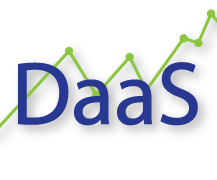Data-as-a-Service In 2016

Up until the last year, big data was a delicacy reserved for the Fortune 500 companies – the big players across industries like retail, pharma, and finances – who invested millions of dollars to acquire innovative big data technologies and hire the best talents to use them to leverage big data up to the hilt. Lately, the small and medium enterprises have found out their own way to cut through the cost and complexity of data. That way out is the service offering termed as Data-as-a-Service, or DaaS.
DaaS helps to capitalize on big data without asking for a staff exclusively hired for big data collection and analysis. It is built on the concept that a product (in this case data) can be provided to a user regardless of organizational or geographical boundaries. It brings on board the idea that data can be acquired, cleansed, and enriched in a centralized place and offered to different users. It helps a user to transcend the limitations of technical capabilities to acquire data projects.

Agility: A user does not need to have extensive knowledge on data. Location specific requirements and slight changes in data structures can be accommodated as implementation is easy due to changes being minimal. As a result, movement across the workflow is fast.
Data quality: Since there is a single point for updates and access to the data lies with the data service, ambiguity regarding changes is minimal. Hence, data quality is not compromised. Only regression testing is required after a thorough checking of the data services, if the same services are called on for the next deployment.
Cost effectiveness: Data experts and providers can together make the base and outsource the presentation layer, facilitating cost effective user interfaces. In addition, change requests at the presentation level become much easier.
DaaS will enable better analysis and storytelling as various users having different technical capabilities across industries adopt data projects. Business analysts will be able to find stories more easily with the new services and technologies, and the role of customized development will gradually become irrelevant. Tools like DaaS will let them find the right content, visualize the data, and provide it to other groups.
Another important trend related to DaaS that will be visible in 2016 is datafication. Datafication is the concept that anything can be turned into some sort of data that can be recorded and stored into a database. Valuable external data is available online. For example, when customers express their feelings about a product on Twitter or Facebook, they are generating data that is not available internally to the company that makes that product. Whom people are friends with, what political thought they endorse, what kind of consumer goods they are interested in, etc., is all external data available publicly. With the increasing number of DaaS vendors and competitive pricing, more and more companies will be able to leverage this data.
What are your thoughts on the idea of Daas? Leave your comments below.
